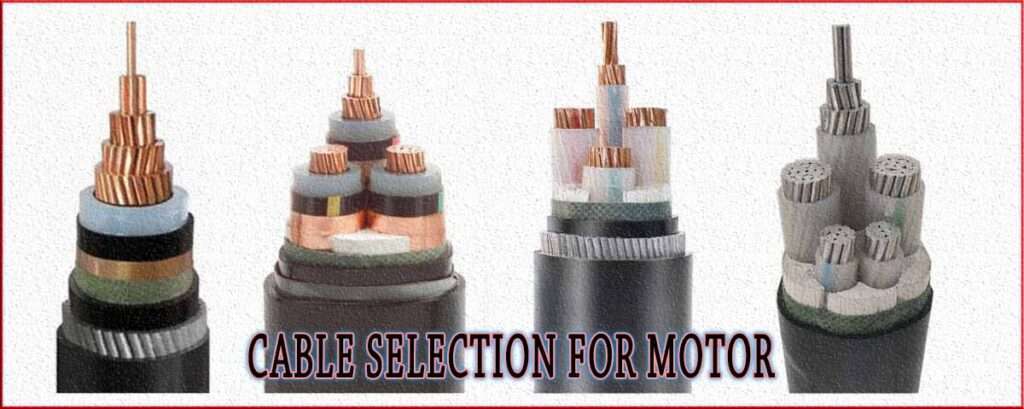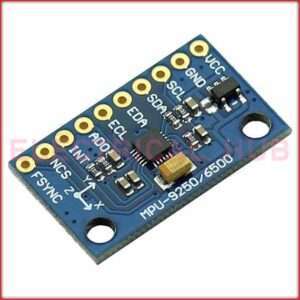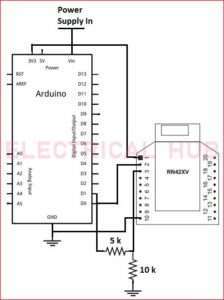Cable Selection for Motor: Important Formulas & Tables
When it comes to powering motors, one of the critical aspects to consider is the cable selection for motor. This decision plays a pivotal role in ensuring the smooth and efficient operation of the motorized system. The cable selection for motor involves choosing the right cable type, size, and rating that can handle the electrical load and environmental conditions while minimizing power losses.

Cable selection for motor
Cable selection for motor is a multi-faceted process that requires careful attention to various factors. One of the primary considerations is the motor’s power rating, voltage, and current requirements. These parameters directly influence the cable selection for motor as they dictate the cable’s ability to carry the required electrical load without overheating or voltage drop.
Read More
In the cable selection for motor, cable sizing plays a vital role. The cable size is determined by calculating the current-carrying capacity of the cable, which depends on factors like conductor material, insulation type, ambient temperature, and installation method. To calculate the required cable rating, several formulas come into play:
Voltage Drop Calculation Formula
Voltage Drop (%) = (Voltage Drop / Source Voltage) × 100 Voltage Drop
Voltage Drop (%) = 2 × K × I × L × (R / 1000) / A
Where:
- K = Specific resistivity of cable material (ohm mm^2/m)
- I = Current (Amps)
- L = Cable Length (meters)
- R = Resistance of cable (ohms/m)
- A = Cross-sectional area of the conductor (mm^2)
Current Carrying Capacity Calculation Formula:
Current Capacity (Amps) = K × A × ΔT / R
Where:
- K = Constant depending on insulation and installation method
- A = Cross-sectional area of the conductor (mm^2)
- ΔT = Maximum allowable temperature rise (°C)
- R = Resistance of the conductor (ohms/m)
Voltage Drop Correction Factor Formula:
Correction Factor = 1 + (ΔT / 234.5)
Where:
- ΔT = Maximum allowable temperature rise (°C)
Cable selection for motor is not a one-size-fits-all scenario. It requires customized calculations to ensure that the chosen cable can handle the specific motor’s requirements.

Table of Current Carrying Capacity of Different Cables
Here’s an expanded table that includes not only the current carrying capacity but also additional parameters such as voltage rating and insulation type for different cable sizes in square millimeters (mm²).
| Cable Size (mm²) | Approx. Current Carrying Capacity (A) | Voltage Rating (V) | Insulation Type |
| 1.0 | 10 – 15 | 300 – 500 | PVC, XLPE |
| 1.5 | 15 – 20 | 300 – 500 | PVC, XLPE |
| 2.5 | 20 – 25 | 300 – 500 | PVC, XLPE |
| 4.0 | 25 – 35 | 300 – 500 | PVC, XLPE |
| 6.0 | 35 – 50 | 300 – 500 | PVC, XLPE |
| 10.0 | 50 – 70 | 300 – 1000 | PVC, XLPE |
| 16.0 | 70 – 100 | 300 – 1000 | PVC, XLPE |
| 25.0 | 100 – 130 | 300 – 1000 | PVC, XLPE |
| 35.0 | 130 – 160 | 300 – 1000 | PVC, XLPE |
| 50.0 | 160 – 200 | 300 – 1000 | PVC, XLPE |
| 70.0 | 200 – 250 | 300 – 1000 | PVC, XLPE |
| 95.0 | 250 – 300 | 300 – 1000 | PVC, XLPE |
| 120.0 | 300 – 350 | 300 – 1000 | PVC, XLPE |
| 150.0 | 350 – 400 | 300 – 1000 | PVC, XLPE |
| 185.0 | 400 – 450 | 300 – 1000 | PVC, XLPE |
| 240.0 | 450 – 550 | 300 – 1000 | PVC, XLPE |
The insulation type mentioned here (PVC – Polyvinyl Chloride, XLPE – Cross-Linked Polyethylene) is just an example. Different cables may have different insulation materials based on their intended applications and environmental conditions.
Table of Current Carrying Capacity & Motor Rated Power
Here’s a table for selecting motor cables based on motor power (kilowatts), cable sizes in square millimeters (mm²), and additional parameters such as voltage rating and insulation type.
| Motor Power (kW) | Cable Size (mm²) | Approx. Current Carrying Capacity (A) | Voltage Rating (V) | Insulation Type |
| Up to 1 | 1.5 | 10 – 15 | 300 – 500 | PVC, XLPE |
| 1 – 2 | 2.5 | 15 – 20 | 300 – 500 | PVC, XLPE |
| 2 – 3 | 4.0 | 20 – 25 | 300 – 500 | PVC, XLPE |
| 3 – 5 | 6.0 | 25 – 35 | 300 – 500 | PVC, XLPE |
| 5 – 7.5 | 10.0 | 35 – 50 | 300 – 1000 | PVC, XLPE |
| 7.5 – 11 | 16.0 | 50 – 70 | 300 – 1000 | PVC, XLPE |
| 11 – 15 | 25.0 | 70 – 100 | 300 – 1000 | PVC, XLPE |
| 15 – 18.5 | 35.0 | 100 – 130 | 300 – 1000 | PVC, XLPE |
| 18.5 – 22 | 50.0 | 130 – 160 | 300 – 1000 | PVC, XLPE |
| 22 – 30 | 70.0 | 160 – 200 | 300 – 1000 | PVC, XLPE |
| 30 – 37 | 95.0 | 200 – 250 | 300 – 1000 | PVC, XLPE |
| 37 – 45 | 120.0 | 250 – 300 | 300 – 1000 | PVC, XLPE |
| 45 – 55 | 150.0 | 300 – 350 | 300 – 1000 | PVC, XLPE |
| 55 – 75 | 185.0 | 350 – 400 | 300 – 1000 | PVC, XLPE |
| 75 – 90 | 240.0 | 400 – 450 | 300 – 1000 | PVC, XLPE |
| Above 90 | Consult Expert | Consult Expert | Consult Expert | Consult Expert |
As motor power increases, cable sizes and current carrying capacities need to be carefully considered. The insulation type (PVC – Polyvinyl Chloride, XLPE – Cross-Linked Polyethylene) mentioned here is just an example.
examples of cable size calculations
Let’s consider a few examples of cable size calculations for both AC and DC motors:
Example of AC Motor: Cable Size Calculation for AC Motor Suppose we have an AC motor with a power rating of 5 kW, operating at 230V, and a distance of 25 meters between the motor and the power source. The motor has a full-load current of 20 amps, and the allowable voltage drop is 5%.
Using the above formulas, we can calculate the required cable size:
Calculate the voltage drop: Voltage Drop = 2 × K × I × L × (R / 1000) / A
Calculate the cross-sectional area (A) using the current-carrying capacity formula.
Example of DC Motor: Cable Size Calculation for DC Motor Consider a DC motor with a power rating of 3 kW, running on a 48V DC supply. The distance from the power source is 15 meters, and the maximum allowable voltage drop is 3%. The motor’s full-load current is 75 amps, and the ambient temperature is 30°C.
Using the formulas provided above, determine the required cable size to ensure efficient power transmission for the DC motor.
Example of AC Motor: Cable Size Calculation for Another AC Motor Let’s take an AC motor with a power rating of 10 kW, operating at 400V. The motor is located 30 meters away from the power source. The maximum allowable voltage drop is 4%, and the full-load current is 18 amps. Calculate the appropriate cable size for this AC motor based on the given parameters and cable selection criteria.
In conclusion, proper cable selection for motor is a critical step in maintaining the efficiency and reliability of motorized systems. Careful consideration of power requirements, cable sizing, and voltage drop ensures that the selected cables can handle the electrical load while minimizing losses.
Using the provided formulas and examples, engineers and technicians can accurately calculate the required cable rating for various motor applications, both AC and DC.
Subscribe to our Newsletter “Electrical Insights Daily” to get the latest updates in Electrical Engineering. You can also Follow us LinkedIn and Facebook to see our latest posts on Electrical Engineering Topics.






